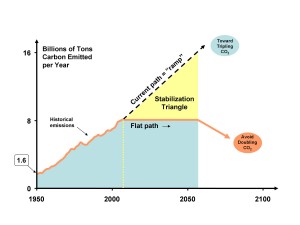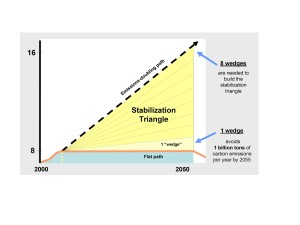In 2004, Stephen Pacala and Robert H. Socolow published “Stabilization Wedges: Solving the Climate Problem for the Next 50 Years with Current Technologies” (PDF) in the journal, Science.
Rather than coming up with one BIG solution to global warming – an elevator down from dangerously high atmospheric temperatures – they conceived of a stack of relatively slender “wedges” that can provide us with a way – a somewhat more gradual escalator – back down to sustainable levels of atmospheric carbon dioxide and other greenhouse gasses using technologies and practices we already know about.
There are four stabilization strategies:
- Decarbonization of Fuel
- Decarbonization of Power
- Efficiency & Conservation
- Forests & Agricultural Soils
Eight “wedges” of these strategies in any number of combinations would add up to the change we need to make in order to level off the climate’s increasing temperature over the next 50 years or so.
It is neither a simple nor controversy-free model for achieving a sustainable atmospheric temperature, but it is a useful way of organizing activities related to climate change.
And, it is instructive to consider that we might already have within reach the technology and information we need to save ourselves and the planet.
For more about Pacala and Socolow’s ongoing work with “stabilization wedges” as well as a wealth of other information, visit Princeton University’s Carbon Mitigation Initiative.


